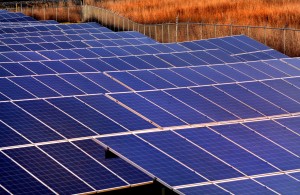Cross posted from Power for the People VA
 Dominion Virginia Power has begun making good on its commitment to install 400 megawatts of solar in Virginia, a goal we have been cheering. Dominion argues its projects make economic sense. That leads us to wonder: if 400 MW makes economic sense, would more be even better? As guest blogger Will Driscoll reveals, we don’t need to speculate; Dominion ran the numbers. They just didn’t like the answer.
Dominion Virginia Power has begun making good on its commitment to install 400 megawatts of solar in Virginia, a goal we have been cheering. Dominion argues its projects make economic sense. That leads us to wonder: if 400 MW makes economic sense, would more be even better? As guest blogger Will Driscoll reveals, we don’t need to speculate; Dominion ran the numbers. They just didn’t like the answer.
By Will Driscoll
Dominion Virginia Power modeled a resource plan with 15,000 megawatts of solar power, which it calculated would save Virginia customers $1.5 billion compared to a plan that includes a $19 billion nuclear reactor. Yet when the company submitted its menu of resource options to regulators at the State Corporation Commission as part of its 2016 Integrated Resource Plan (IRP), it included the North Anna 3 nuclear plant while omitting the high-solar option.
The high-solar option only became public when attorneys Will Cleveland and Peter Stein of the Southern Environmental Law Center (SELC), representing an environmental coalition, asked the right questions during the discovery phase of the IRP proceedings.
Utilities in 33 states must periodically file an IRP. The IRP is intended to define the least-cost set of resources that can meet forecasted electricity demand plus a reserve margin, while also meeting the state’s policy goals on renewables and efficiency. Utilities use computer models to develop an IRP.
Dominion’s utility planning model generated the 15,000-megawatt solar option when the utility set no constraint on the amount of solar that could be added.
The high-solar plan would actually save Virginians much more than $1.5 billion, according to an expert witness in the IRP hearing, former Texas Public Utility Commissioner Karl Rabago. The projected $1.5 billion in savings would be after Dominion’s projected $5.8 billion of solar integration costs (i.e., any costs needed to adapt the grid for a high level of solar). Yet the $5.8 billion value “is at least 54 to 84 percent higher than the PJM high and low [integration cost] numbers that [Dominion] cites,” Rabago said. Thus, “the overall savings … [with] a more reasonable approach to the integration costs would be much higher than $1.5 billion.” (PJM is a regional transmission organization that coordinates the movement of electricity through Virginia, Maryland, Delaware, New Jersey, Pennsylvania, Ohio, the District of Columbia, and parts of seven other states.)
To those who have followed the low and still-falling costs of utility-scale solar, it may not be surprising that solar, including any integration costs, would cost less than the proposed North Anna 3 nuclear reactor. But to learn that Dominion’s own utility planning model presented that result to Dominion is a revelation.
To justify discarding the high-solar option, Dominion executive Robert Thomas said that “15,000 megawatts of solar… was a lot of land.” Yet data from the National Renewable Energy Laboratory show that this amount of solar would need only 0.4 percent of Virginia’s land area (i.e., 15000 MW times 7.9 acres per MW, divided by 27.376 million acres of land). Mr. Thomas also said that the high-solar option “could create reliability issues,” yet high-renewables utilities in Iowa, South Dakota, California and Europe are highly reliable, thanks to accurate day-ahead weather forecasting and sophisticated utility “unit commitment” models that are also available to Dominion.
The State Corporation Commission, in its final order regarding Dominion’s IRP, did not mention the high-solar option. The SCC approved the IRP as submitted, noting that “approval of an IRP does not in any way create the slightest presumption that resource options contained in the approved IRP will be approved in a future certificate of public convenience and necessity (“CPCN”), rate adjustment clause (“RAC”), fuel factor, or other type of proceeding governed by different statutes.”
SELC attorney Will Cleveland called on Dominion and the SCC to do better next time: “Citing ‘feasibility concerns,’ Dominion rejected and buried the high solar resource plan without any legitimate analysis of whether the plan was in fact feasible. Virginia ratepayers deserve the lowest-cost, cleanest energy available, and it is increasingly clear that means more solar, not more fossil fuels or nuclear. In the future, Dominion should not be allowed to dismiss the cheaper, cleaner resource plan without a full analysis.”
The environmental coalition represented by SELC consisted of Appalachian Voices, Chesapeake Climate Action Network, the Virginia Chapter of the Sierra Club, and SELC itself.
Will Driscoll is a writer and analyst. Previously he conducted environmental analyses for EPA, as a project manager for ICF Consulting. His publications include the book Nonproliferation Primer (MIT Press).















